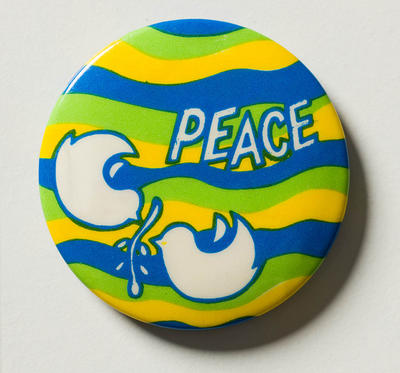Campaign/protest badge
Production date
1970s
See full details
Object detail
Description
Circular vinyl-coated tin badge featuring blue, green and yellow wavy stripes, two stylised white doves with an olive branch betweenand /PEACE/ in blue-bordered white lettering.
Classification
NUMISMATICS (MEDALS AND OTHER) Badges Civil button badge
Maker
Production date
1970s
Measurements
Diameter 30mm
Media/Materials description
Enamel
Tin
Tin
Signature/Marks
PEACE
History and use
The Isobel Harvey collection consists of twenty-five badges collected by Isobel while working on the 1972 election campaign for the Australian Labor Party, during her membership of the Women’s Electoral Lobby and through the period of her employment in the Victorian trade union movement.
Representative of wearable, cheap and easy to make protest paraphernalia, these badges document key environmental, social and political issues, event and movements of the 1970s and 1980s, including the rise of the international Peace and Women's movements.
Many of the badges were made by the well-known Melbourne family business, Patrick Brothers. Established in the early 1940s, the company was the first to design and produce the ‘one-piece badge’, with a single piece of tin wrapped around with the pin on top. Patrick Brothers’ archives include many iconic badges that are sought after by collectors today.
Documenting key social ideas of the period, the badges are a material record of community protest movements such as nuclear disarmament, environmental campaigns like the Tasmanian Wilderness Society's ‘Save the Franklin’ campaign and the Women’s Electoral Lobby (WEL) campaign for women’s equity and justice. Four others commemorate May Day marches which the donor attended between 1985 and 1990, including the hundred-year celebration of Australia’s first May Day meeting in 1890.
While it could be argued that the badges interpret a predominantly Victorian narrative, as transmitters of ideas, principles and objectives, the symbols and slogans and organisations they represent exemplify national issues of concern at that time and were widely available and collected throughout Australia, including Queensland.
Representative of wearable, cheap and easy to make protest paraphernalia, these badges document key environmental, social and political issues, event and movements of the 1970s and 1980s, including the rise of the international Peace and Women's movements.
Many of the badges were made by the well-known Melbourne family business, Patrick Brothers. Established in the early 1940s, the company was the first to design and produce the ‘one-piece badge’, with a single piece of tin wrapped around with the pin on top. Patrick Brothers’ archives include many iconic badges that are sought after by collectors today.
Documenting key social ideas of the period, the badges are a material record of community protest movements such as nuclear disarmament, environmental campaigns like the Tasmanian Wilderness Society's ‘Save the Franklin’ campaign and the Women’s Electoral Lobby (WEL) campaign for women’s equity and justice. Four others commemorate May Day marches which the donor attended between 1985 and 1990, including the hundred-year celebration of Australia’s first May Day meeting in 1890.
While it could be argued that the badges interpret a predominantly Victorian narrative, as transmitters of ideas, principles and objectives, the symbols and slogans and organisations they represent exemplify national issues of concern at that time and were widely available and collected throughout Australia, including Queensland.
Associated person
Registration number
H50493



